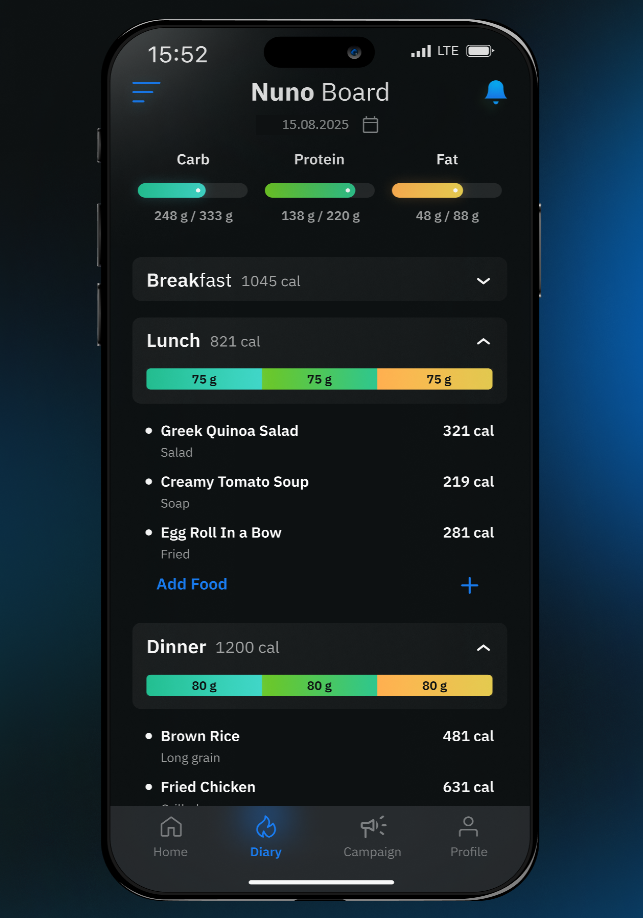Discover the 40-40-20 method: A simple way to build balanced meals – perfect for healthy eating, even without daily tracking.
In our last blog post, we explained why nutrition tracking isn’t weird, it’s your real-life superpower.
But what if you don’t have the time or simply don’t feel like tracking every meal?
That’s where the 40-40-20 method comes in. A simple alternative that still gives you structure and helps you get through the day with balanced, healthy meals, without counting every gram.
Balanced eating without the overwhelm
In today’s fast-paced world, nutrition often feels complicated. Counting calories, weighing food, logging every detail, it all takes time and mental energy. For many, that’s overwhelming.
But there’s good news: eating balanced doesn’t have to be a math exercise. The 40-40-20 method is a simple, visual approach that helps you build healthy meals without the stress of constant tracking.
It’s quick, intuitive, and flexible enough to fit into almost any lifestyle.
The 40-40-20 approach: Divide your plate for balance
Imagine a standard plate, divided into three sections:
- 40% protein
- 40% fiber-rich carbohydrates (mostly vegetables)
- 20% starchy carbohydrates
This straightforward breakdown helps you hit a balanced ratio of macros with just one look – no app, no calculator.
Example:
- Chicken breast (40%)
- Steamed broccoli and salad (40%)
- A small portion of rice or potatoes (20%)
Why this method works – even without tracking
The strength of the 40-40-20 method lies in its simplicity. Even when you’re not actively tracking your nutrition, it:
- Keeps meals balanced and nutrient-dense
- Trains your eye for better portion control
- Prevents the “all-or-nothing” mindset when you can’t log every bite
- Supports energy, satiety, and recovery throughout the day
And here’s the bonus: once you return to tracking with an app, you’ll notice your natural sense of balance has improved dramatically.
Everyday application: tips & examples
Tips for Everyday Use
- Use fats in moderation: Add healthy fats like avocado, olive oil, or nuts – but keep portions small.
- Choose water over sugar: Prioritize water or unsweetened tea, avoid sugary drinks and alcohol.
- Stay flexible: The 40-40-20 principle works with any diet – vegan, vegetarian, or omnivorous.
Meal examples
- Breakfast: Greek yogurt (protein), berries and chia seeds (fiber), oats (starchy carbs).
- Lunch: Grilled salmon (protein), roasted vegetables (fiber), quinoa (starchy carbs).
- Dinner: Lentil stew (protein), spinach and kale salad (fiber), a slice of whole-grain bread (starchy carbs).
With a little creativity, you can apply the method to restaurant meals, meal prep, or even quick snacks.

Conclusion: Simple structure, less pressure
Eating healthy doesn’t need to feel like a chore. The 40-40-20 method is your shortcut to balanced meals, even when life is busy and you don’t want to track every bite.
And when you do want deeper insights, the nuno appis there to support you with smart food tracking, making it effortless to see exactly where you stand.
Less stress. More balance.
Frequently Asked Questions (FAQ)
Do I need to count calories with the 40-40-20 method?
No. It’s a visual approach – just divide your plate. No calorie counting needed.
Does it work with a vegan or vegetarian diet?
Absolutely. Swap in tofu, lentils, beans, or tempeh for protein.
Is this enough to reach fitness goals?
It gives you structure. For specific goals like muscle growth or fat loss, tracking adds extra clarity.
What about snacks?
The method mainly applies to main meals. Snacks can fit in flexibly, just try to include at least one protein source.
When should I track instead of estimate?
When you want measurable progress – e.g., for weight loss, strength gains, or preparing for a competition.
How do I apply this method when eating out?
Look at your plate: prioritize a protein source, fill half the remaining space with vegetables or salad, and leave the smallest portion for starches.
#nutrition